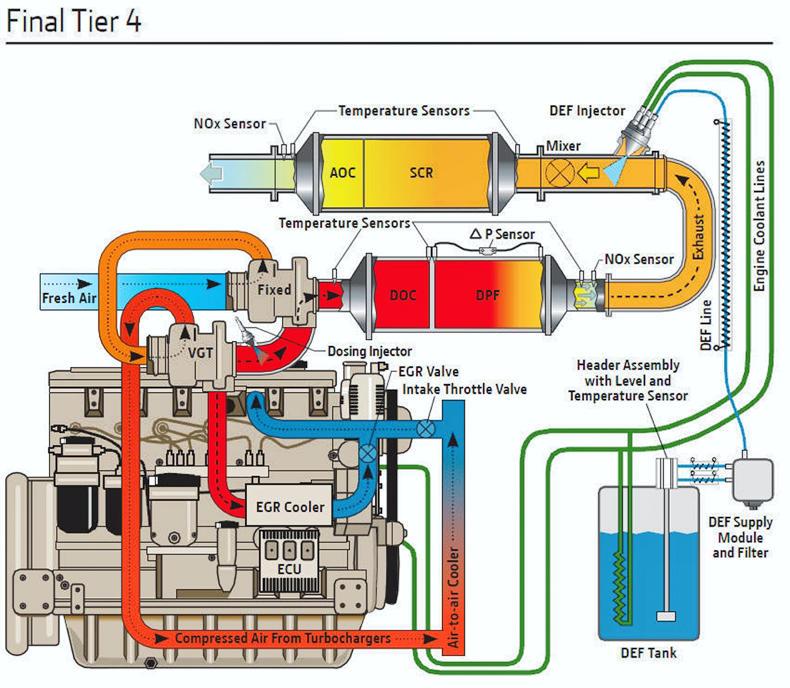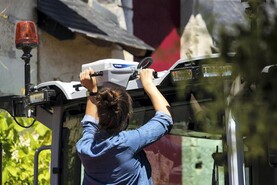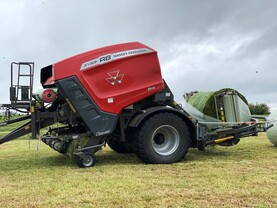The humble four-stroke diesel engine is well over 100 years old at this stage. A little over two decades ago it was decided to clean up diesel engine emissions. This prompted manufactures to look at their engine designs, improve what was already there and develop new technology to make them even cleaner.
Targets were set on emissions reduction levels and this led to a significant investment by many manufacturers across the board. In the agricultural sector there is quite a mix of dedicated engine manufacturers.
These include Deutz, Perkins (CAT) and Cummins plus agri borne manufacturers such as John Deere, SDF, AGCO Power and FPT. Into the middle of this emissions control melee entered JCB with its own engine design.

JCB EcoMAX 4.8-litre- after-treatment 01 JCB Power Systems will use a combination of next-generation particulate control technology, incorporating a diesel oxidation catalyst (DOC), integrated diesel particulates filter (DPF) and selective catalytic reduction (SCR) to meet European Stage V emissions regulations.
The race to emissions regulation has been a very interesting one over the past couple of decades. Meeting the regulations of each Tier/Stage, may certainly have been challenging for tractor and engine manufacturers. The down side of developing and manufacturing ever-cleaner engines is ever-increasing cost for both manufacturer and end user.
Tier 1/Stage I regulations were introduced as far back as 1996. Cleaning up engine emissions had a positive effect not just on the environment, but also on engine design and performance. Many would regard the following decade as the golden era of tractor/agricultural engine design. Better performance – torque, power and fuel economy – without too many add-ons.
From Tier 2/Stage II, and in particular Tier 3/ Stage IIIA upwards, engine manufacturers’ approaches really started to get interesting. The introduction of electronic fuel injection and in particular common-rail fuel injection was ultimately seen as a key solution to begin meeting exhaust emissions standards.
There was a slight parting of ways here among competing manufacturers. This was essentially driven by what method was chosen to treat NOx levels
So meeting Tier 3/Stage IIIA and Interim Tier 4/Stage IIIB regulations presents even more – a further reduction of two main pollutants of a diesel engine’s exhaust emissions. These are nitrogen oxides (NOx) and soot or particulate matter (PM).
There was a slight parting of ways here among competing manufacturers. This was essentially driven by what method was chosen to treat NOx levels.
NOx is produced by the high temperatures of the exhaust process. There are two main ways of tackling them. EGR-Exhaust Gas Recirculation reduces the combustion temperature within the engine, and NOx produced, by re-circulating some of the exhaust gases into the combustion process.
This is done by a relatively small EGR valve bolted to the engine. It is electronically controlled, as is the variable geometry turbocharger often used in conjunction.
The second method is to treat NOx after it has left the engine. This is done through SCR-Selective Catalytic Reduction, which many would consider a far cleaner method of reducing NOx content and doesn’t interfere with the combustion process.
The electronically controlled SCR unit injects ammonia-based DEF-Diesel Exhaust Fluid (AdBlue) into the exhaust stream. Here it mixes in the SCR catalyst to reduce the NOx content, converting it to nitrogen and water vapour. Cleaner, but a second fuel some argued at the time!
There are lots of arguments for and against both methods of treating NOx content. The EGR route meant manufacturers that utilised this method generally didn’t have to adopt AdBlue till a later Tier/Stage. But by Interim Tier 4/Stage IIIB they usually had to fit a DPF (diesel particulate filter) to catch and burn soot particles (notably John Deere and Cummins).

John Deere Tier 4_Stage 4 technology diagram This diagram from John Deere demonstrates what the manufacturer employs to meet Tier-4/Stage IV emission regulations.
The use of DPF was initially a little bit hair-raising initially in an agricultural context. They catch soot particles and periodically ‘re-generate’ to burn up the soot particles and clear the DPF. This could be a bit nerve-wracking, especially when working with some very dry and flammable material. Agricultural tractors and machines all featured a facility to pause the re-generation for a more suitable time, which seems to largely solve the fire-fear.
Overall, emissions control solutions vary from manufacturer to manufacturer, and also depending on solution required. At Tier-4 Final and upwards, SCR and high-pressure commonrail fuel injection is virtually common across the board. As explained earlier, some manufacturers may also use DPF, EGR, VGT and more to ensure engines are compliant.
In 2019, many agricultural manufacturers will begin introducing products with engines featuring Stage V-compliant engines in certain power categories. Regardless of engine or tractor make, the technology required to ensure the diesel burner under the hood meets Stage V regulations is quite phenomenal.
While ever-greener and safer for the environment, the down-side, as with every level introduced, will no doubt be an increase in cost for the consumer/farmer. If cost of meeting emissions regulations continues to rise, then what next? Methane power (New Holland)? Electric? Engine manufacturer Deutz is already experimenting with hybrid and electric drive systems, as recently seen in two Manitou loaders. The firm stated: “In 2022/2023, Deutz plans to achieve between 5% and 10% of its overall sales revenue from electrified drives.”
The humble four-stroke diesel engine is well over 100 years old at this stage. A little over two decades ago it was decided to clean up diesel engine emissions. This prompted manufactures to look at their engine designs, improve what was already there and develop new technology to make them even cleaner.
Targets were set on emissions reduction levels and this led to a significant investment by many manufacturers across the board. In the agricultural sector there is quite a mix of dedicated engine manufacturers.
These include Deutz, Perkins (CAT) and Cummins plus agri borne manufacturers such as John Deere, SDF, AGCO Power and FPT. Into the middle of this emissions control melee entered JCB with its own engine design.

JCB EcoMAX 4.8-litre- after-treatment 01 JCB Power Systems will use a combination of next-generation particulate control technology, incorporating a diesel oxidation catalyst (DOC), integrated diesel particulates filter (DPF) and selective catalytic reduction (SCR) to meet European Stage V emissions regulations.
The race to emissions regulation has been a very interesting one over the past couple of decades. Meeting the regulations of each Tier/Stage, may certainly have been challenging for tractor and engine manufacturers. The down side of developing and manufacturing ever-cleaner engines is ever-increasing cost for both manufacturer and end user.
Tier 1/Stage I regulations were introduced as far back as 1996. Cleaning up engine emissions had a positive effect not just on the environment, but also on engine design and performance. Many would regard the following decade as the golden era of tractor/agricultural engine design. Better performance – torque, power and fuel economy – without too many add-ons.
From Tier 2/Stage II, and in particular Tier 3/ Stage IIIA upwards, engine manufacturers’ approaches really started to get interesting. The introduction of electronic fuel injection and in particular common-rail fuel injection was ultimately seen as a key solution to begin meeting exhaust emissions standards.
There was a slight parting of ways here among competing manufacturers. This was essentially driven by what method was chosen to treat NOx levels
So meeting Tier 3/Stage IIIA and Interim Tier 4/Stage IIIB regulations presents even more – a further reduction of two main pollutants of a diesel engine’s exhaust emissions. These are nitrogen oxides (NOx) and soot or particulate matter (PM).
There was a slight parting of ways here among competing manufacturers. This was essentially driven by what method was chosen to treat NOx levels.
NOx is produced by the high temperatures of the exhaust process. There are two main ways of tackling them. EGR-Exhaust Gas Recirculation reduces the combustion temperature within the engine, and NOx produced, by re-circulating some of the exhaust gases into the combustion process.
This is done by a relatively small EGR valve bolted to the engine. It is electronically controlled, as is the variable geometry turbocharger often used in conjunction.
The second method is to treat NOx after it has left the engine. This is done through SCR-Selective Catalytic Reduction, which many would consider a far cleaner method of reducing NOx content and doesn’t interfere with the combustion process.
The electronically controlled SCR unit injects ammonia-based DEF-Diesel Exhaust Fluid (AdBlue) into the exhaust stream. Here it mixes in the SCR catalyst to reduce the NOx content, converting it to nitrogen and water vapour. Cleaner, but a second fuel some argued at the time!
There are lots of arguments for and against both methods of treating NOx content. The EGR route meant manufacturers that utilised this method generally didn’t have to adopt AdBlue till a later Tier/Stage. But by Interim Tier 4/Stage IIIB they usually had to fit a DPF (diesel particulate filter) to catch and burn soot particles (notably John Deere and Cummins).

John Deere Tier 4_Stage 4 technology diagram This diagram from John Deere demonstrates what the manufacturer employs to meet Tier-4/Stage IV emission regulations.
The use of DPF was initially a little bit hair-raising initially in an agricultural context. They catch soot particles and periodically ‘re-generate’ to burn up the soot particles and clear the DPF. This could be a bit nerve-wracking, especially when working with some very dry and flammable material. Agricultural tractors and machines all featured a facility to pause the re-generation for a more suitable time, which seems to largely solve the fire-fear.
Overall, emissions control solutions vary from manufacturer to manufacturer, and also depending on solution required. At Tier-4 Final and upwards, SCR and high-pressure commonrail fuel injection is virtually common across the board. As explained earlier, some manufacturers may also use DPF, EGR, VGT and more to ensure engines are compliant.
In 2019, many agricultural manufacturers will begin introducing products with engines featuring Stage V-compliant engines in certain power categories. Regardless of engine or tractor make, the technology required to ensure the diesel burner under the hood meets Stage V regulations is quite phenomenal.
While ever-greener and safer for the environment, the down-side, as with every level introduced, will no doubt be an increase in cost for the consumer/farmer. If cost of meeting emissions regulations continues to rise, then what next? Methane power (New Holland)? Electric? Engine manufacturer Deutz is already experimenting with hybrid and electric drive systems, as recently seen in two Manitou loaders. The firm stated: “In 2022/2023, Deutz plans to achieve between 5% and 10% of its overall sales revenue from electrified drives.”








 This is a subscriber-only article
This is a subscriber-only article














SHARING OPTIONS: